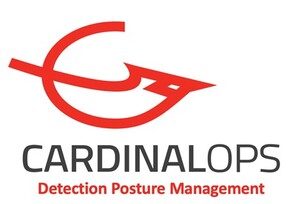CardinalOps' third annual report analyzes real-world data from production SIEMs covering nearly 4,000 detection rules across diverse industry verticals
TEL AVIV, Israel and BOSTON, June 27, 2023 /PRNewswire/ -- CardinalOps, the detection posture management company, today released its Third Annual Report on the State of SIEM Detection Risk. The report analyzes real-world data from production SIEMs – including Splunk, Microsoft Sentinel, IBM QRadar, and Sumo Logic – covering more than 4,000 detection rules, nearly one million log sources, and hundreds of unique log source types.
The data spans diverse industry verticals including banking and financial services, insurance, manufacturing, energy, media & telecommunications, professional & legal services, and MSSP/MDRs.
Assessing and Strengthening SIEM Effectiveness
According to industry analysts, the SIEM continues to be the "operating system of the SOC" and is not going away anytime soon.
However, most organizations face the challenge of how to continuously assess and strengthen the effectiveness of their existing SIEMs, using standard frameworks like MITRE ATT&CK to measure their readiness to detect the highest-priority threats. This is a major challenge because organizations have to grapple with constant change in adversary techniques plus constantly expanding attack surfaces, combined with the difficulty of hiring and retaining skilled detection engineers.
These challenges are clearly illustrated in data from this year's SIEM Detection Risk report. Using MITRE ATT&CK as the baseline, CardinalOps found that, on average:
- Actual detection coverage remains far below what most organizations expect: Enterprise SIEMs only have detections for 24% of all MITRE ATT&CK techniques. That means they're missing detections for around three-quarters of all techniques that adversaries use to deploy ransomware, steal sensitive data, and execute other cyberattacks.
- SIEMs don't need more data: SIEMs are already ingesting sufficient data to potentially cover 94% of all MITRE ATT&CK techniques. But many enterprises are still relying on manual and error-prone processes for developing new detections, making it difficult to reduce their backlogs and act quickly to plug detection gaps. A more effective strategy would be to scale SIEM detection engineering processes to develop more detections faster, via automation.
- Broken rules are also common: 12% of SIEM rules are broken and will never fire due to data quality issues such as misconfigured data sources and missing fields – resulting in increased risk of breach due to undetected attacks.
- Organizations are implementing "detection-in-depth"– but monitoring of containers lags behind: Enterprise SIEMs are following best practices and collecting data from multiple security layers such as Windows endpoints (96%), network (96%), IAM (96%), Linux/Mac (87%), cloud (83%), and email (78%). But monitoring of containers lags far behind other layers at only 32%, despite Red Hat data showing that 68% of organizations are running containers. This low number could be because it's challenging for detection engineers to write high-fidelity detections to uncover anomalous behavior in these highly-dynamic environments.
"These findings illustrate a simple truth: most organizations don't have good visibility into their MITRE ATT&CK coverage and are struggling to get the most from their existing SIEMs," said Michael Mumcuoglu, CEO and Co-Founder at CardinalOps. "This is important because preventing breaches starts with having the right detections in your SIEM – according to the adversary techniques most relevant to your organization – and ensuring they're actually working as intended. Based on the experience of our enterprise customers, leveraging automation and detection posture management are critical capabilities for achieving this.
To help organizations address their detection challenges, the 2023 CardinalOps report also includes a series of best practices to help SOC teams measure and continuously improve the robustness of their detection posture over time.
You can download the full report here.
About CardinalOps
Backed by security experts with nation-state expertise, the CardinalOps platform uses automation and MITRE ATT&CK to continuously ensure you have the right detections in your existing SIEM to prevent breaches, based on a threat-informed strategy.
What's more, it improves detection engineering productivity by 10x and reduces the need to hire additional SOC personnel. Native API-driven integrations include Splunk, Microsoft Sentinel, IBM QRadar, Google Chronicle SIEM, CrowdStrike Falcon LogScale, and Sumo Logic. Learn more at CardinalOps.com.
For Media Inquiries:
Nathaniel Hawthorne for CardinalOps
Lumina Communications
(661) 965-0407
CardinalOps@luminapr.com
SOURCE CardinalOps

WANT YOUR COMPANY'S NEWS FEATURED ON PRNEWSWIRE.COM?
Newsrooms &
Influencers
Digital Media
Outlets
Journalists
Opted In





Share this article